
How Vets Diagnose the Cause of Anisocoria in CatsĪnisocoria is a symptom that can lead to the diagnosis of an underlying disease. Take pictures of your cat’s eyes in the abnormal state for the veterinarian, because occasionally, their eyes can go back to looking normal by the time a vet can examine them. Some causes of anisocoria can progress rapidly, so it’s important to have your cat examined by a veterinarian as soon as you notice the abnormal pupil size. Go to the emergency vet if you notice that one of your cat’s pupils is wider than the other.Īlthough chances are good that the underlying cause is not a true emergency, in this situation, it’s better safe than sorry. What to Do if Your Cat’s Pupils Are Different Sizes Older cats are also more prone to cancer, and cancer within the eye can cause anisocoria in cats. Neurologic disease can contribute to either dilated or constricted pupils in cats.Įating certain toxic plants can cause one pupil to be larger than the other.Ĭertain viral, fungal, and parasitic infections can cause anisocoria in cats, and they are more common in cats that have access to the outdoors or were once strays. The pupil may also constrict inappropriately due to inflammation in the eye or painful conditions like corneal ulcers. Pupils can abnormally dilate due to conditions like glaucoma or damage to the retina in the back of the eye. Here are some of the causes of anisocoria in cats:ĭiseases inside and outside the eye can lead to anisocoria in cats. It is difficult to provide an exhaustive list of all the causes of mismatched pupil sizes in cats because there are so many. Therefore, if you notice your cat’s pupils are different sizes, even occasionally, a veterinary exam is important to uncover the cause. While dogs and people can develop “idiopathic” anisocoria, in which the pupils are occasionally different sizes for no reason at all, this is much rarer in cats. Can Anisocoria in Cats Be Fatal?Īlthough anisocoria itself is not fatal, nor even painful in most cases, the underlying cause is the more important issue. The abnormal eye may have either the smaller or bigger pupil, depending on the cause. When a cat’s pupils do not dilate or constrict appropriately, it can indicate a problem in one or both eyes. A cat’s pupils do this by getting wider or narrower in response to changes in the brightness of their environment. The function of pupils is to control the amount of light entering the eye.

What Is Anisocoria in Cats?Īnisocoria in cats is defined as a significant difference in the pupil size of each eye. Ophthalmic Atlas Images by, The University of Iowa are licensed under a Creative Commons Attribution-NonCommercial-NoDerivs 3.0 Unported License.Go to the emergency vet if you notice that one of your cat’s pupils is wider than the other. In the photo with keen observation, fine pigment can be detected on the surface of the anterior lens capsule. The iris atrophy is best seen with the slit-lamp and transillumination. As a result of several attacks of uveitis, iris atrophy with a fixed, dilated pupil has resulted. The patient is a 32-year-old Caucasian female.

The photo was taken when the eye was not under the influence of mydriatics/cycloplegics. Uveitis with iris atrophy and fixed, dilated pupil Many of his images are significant for their historical perspective and for techniques and conditions seen in settings in undeveloped areas. Caccamise has very generously shared his images of patients taken while operating during the "eye season" in rural India as well as those from his private practice during the 1960's and 1970's. Contributor: William Charles Caccamise, Sr, MD, Retired Clinical Assistant Professor of Ophthalmology, University of Rochester School of Medicine and Dentistry


 0 kommentar(er)
0 kommentar(er)
